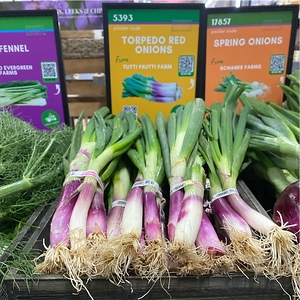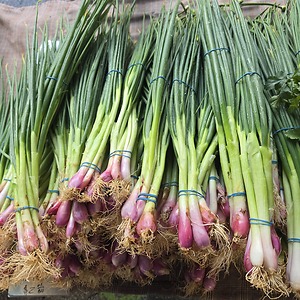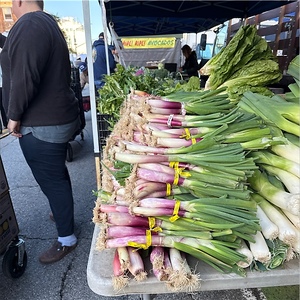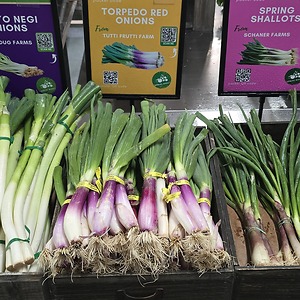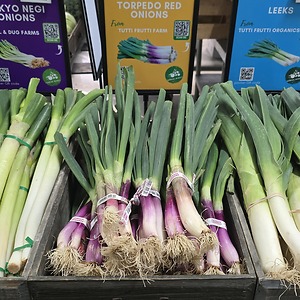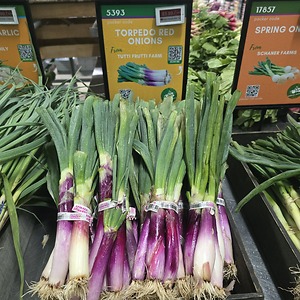

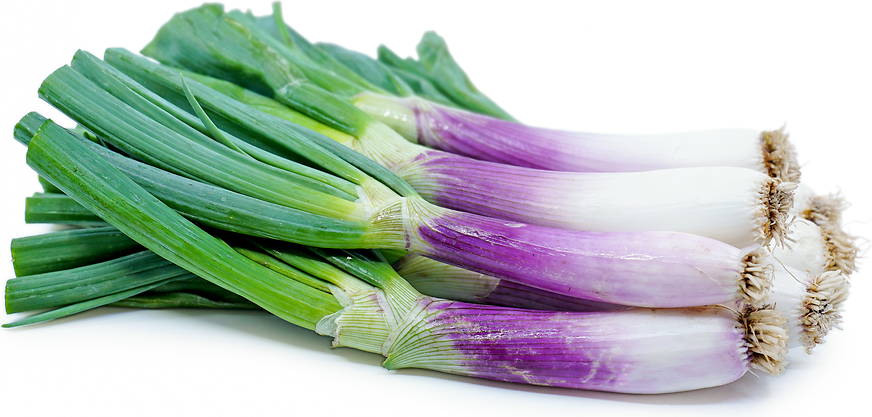
Torpedo Onions
Estimated Inventory, 12 ct : 0
Description/Taste
Torpedo onions vary in size, depending on growing conditions and specific variety, but are generally smaller in size, averaging 7 to 15 centimeters in length. The onions are round, ovoid, or ellipsoidal in shape and often feature tapered, blunt ends. Torpedo onions are known for their distinct elongated appearance. It is important to note that Torpedo onions can be harvested at multiple stages of maturity. When young, they are more cylindrical and have less developed bulbs. As they mature, they transition into their signature elongated shape. The onion’s surface is covered in layers of a brittle, dry, and papery red, brown, and purple peel. This peel is found on dried onions and is a protective covering. Fresh, young onions will be free of this papery layer. When the thin layers are removed, a firm, red-purple, glossy, and smooth surface is revealed with light striping. Torpedo onions are comprised of white rings of flesh bordered with shades of purple and red. These rings are crisp, firm, and aqueous with a crunchy, succulent, and snappy consistency. The onions release a prominent, savory aroma and can be eaten raw or cooked, bearing a mild, sweet, warm, and pungent taste.
Seasons/Availability
Torpedo onions are typically found fresh in markets in the fall through spring. They are also dried and sold year-round.
Current Facts
Torpedo onions, botanically classified as Allium cepa, are a category of red onions belonging to the Amaryllidaceae family. The name Torpedo is a general descriptor used in English-speaking countries for Italian varieties that showcase a distinctly elongated shape and sweeter flavor. Torpedo onions are known by several names worldwide, including Italian Red Torpedo, Long Red Florence, Red Onion of Tropea, Rossa di Tropea, Red Gold of Calabria, La Regina Rossa, Florence Simiane, Rouge de Florence, and Rossa di Firenze. Historically, Torpedo onions arose from the Calabrian region of Italy and became famous for their sweet and pungent taste. Three main types of Torpedo onions are collectively sold under the general name: early ripening, mid-season, and late ripening. Each type produces different-sized onions that are utilized in various culinary preparations. Torpedo onions are traditionally harvested by hand and are sold fresh or dried. Despite their regional popularity in Italy, Torpedo onions are only grown on a small scale in other countries worldwide and are considered a specialty crop sold through fresh markets. The onions are valued for their rich flavoring and are an all-purpose type, allowing them to be incorporated into sweet and savory dishes.
Nutritional Value
Torpedo onions are a source of vitamins A, B6, and C to maintain healthy organs, support brain health, and strengthen the immune system. Torpedo onions also provide fiber to regulate the digestive tract, and anthocyanins have antioxidant properties to reduce inflammation and guard the cells against the damage caused by free radicals. Minerals in onions include manganese, potassium, phosphorus, calcium, magnesium, and iron. Manganese helps the body heal wounds, while potassium balances fluid levels and replenishes electrolytes. Phosphorus and calcium protect bone and teeth development, magnesium controls nerve functions, and iron produces the protein hemoglobin for oxygen transport through the bloodstream. Torpedo onions are low in pyruvic acid, which is responsible for the pungency experienced when eating fresh onions. This lower content allows the natural sugars in the onions to be detected, creating a sweeter taste. While less common, Torpedo onions are sometimes used in natural remedies. Sources have noted that the onions are used to lessen headaches and soothe irritation generated from insect stings. Onions were also once sliced in half and placed beside beds to open airways when suffering from colds.
Applications
Torpedo onions have a sweet and pungent taste suited for fresh and cooked preparations. The onions are popularly served raw and are drizzled with oil, herbs, and spices to help balance flavors. This mixture is often served as a dip for bread and cheese on charcuterie boards. Torpedo onions can be tossed into salads, minced into vinaigrettes, dressings, and sauces, or chopped fresh into grain bowls. Try adding Torpedo onions to salsa or incorporating them into bruschetta. The onions can also be layered in sandwiches and burgers or used in ceviche for a sweeter taste. In addition to fresh preparations, Torpedo onions can be used in any cooked dish calling for onions. The elongated onions are sometimes skewered and grilled to create a caramelized sweetness, and this preparation allows the onions to retain their signature shape for increased visual appeal. They can also be cooked into egg dishes like omelets, frittatas, and scrambles, added to beans, or baked into casseroles and gratins. In Europe, Torpedo onions are simmered into soups and stews. They are also frequently cooked with potatoes, stirred into pasta, or roasted as a simple side. One of the most unusual recipes for Torpedo onions is marmalade, a dish made in the onion’s hometown of Tropea, Italy. The marmalade is comprised of onions and sweet peppers and is slow-cooked to develop a jam-like consistency. This spread is slathered over toasted bread and eaten with cheeses and cold cuts. Torpedo onions are also pickled for extended use as a condiment. If consuming Torpedo onions raw, it is recommended to chew parsley or mint leaves to help freshen the breath. Cardamom seeds or coffee beans are also sometimes chewed. Torpedo onions pair well with herbs including basil, thyme, mint, oregano, and tarragon, cheeses such as taleggio, mozzarella, pecorino, and feta, nuts such as hazelnuts, pine, and pistachios, citrus, and warm spices, including cloves, chili powder, and cardamom. Fresh Torpedo onions should be immediately consumed for the best quality and flavor. The onions will keep for a few days when stored in a cool, dry, and dark location. Braided and dried onions will keep for around one month when placed in a cool area with ample air circulation away from direct sunlight.
Ethnic/Cultural Info
Torpedo onions grown in Calabria, Italy, are protected under a PGI, or Protected Geographical Indication. The label was given to the onions in 2008 to protect the traditional practices used to create the famous onion. In the protected PGI area, Torpedo onions are called Cipolla Rossa di Tropea Calabria, and only the municipalities named according to the PGI certificate can label their onions with the European label. Protected Geographical Indication labels highlight that the crop develops a unique flavor and appearance due to its growing region. Rossa di Tropea onions are sown in fertile, sandy soils near the sea in Calabria. This environment is filled with natural sea breezes and a Mediterranean climate ideal for growing sweet onions. Production is still done mainly by hand, and traditional farming practices are honored. In Tropea, a municipality in the Calabria region of Italy, Rossa di Tropea onions are promoted through an annual festival. The multi-day event features educational talks about the onions, contests, live entertainment, cooking demonstrations, and fresh markets where local vendors can sell their onion-centric products. The festival was created in partnership with the Consorzio Cipolla Rossa di Tropea Calabria, a consortium that protects the onion’s quality, publicity, and popularity. During the festival, Tropea locals claim the best onions can be eaten like an apple, and onion gelato is also a highlight among visitors.
Geography/History
Torpedo onions are descendants of onion varieties introduced to the Italian peninsula through the Phoenicians and the Greeks. It is thought that the Phoenicians, who were from the area now known as modern-day Lebanon in the Middle East, may have first introduced onions in the Vibonese area of Calabria. Commercial trade routes were also established in the port of Parghelia, and the Greeks made trading stops in the region of Calabria and other southern Italian cities. After the onion's introduction through trade, they were planted and cultivated along the coast and selectively bred over time. Torpedo onions later became famous throughout Italy after the arrival of the railroad. The onions could be shipped longer distances and were documented in several written texts and accounts as a popular crop. In the 18th to 19th centuries, onions grown in Calabria were being recognized by communities outside of Italy and were shipped to northern European markets, increasing in demand as a favored culinary ingredient. The onions were also sent to other overseas countries beginning in the 1950s, establishing the onions as a specialty crop. Torpedo onions slowly expanded worldwide and were given an Award of Garden Merit in 2005 by the Royal Horticultural Society in England for their favorable cultivation characteristics in home gardens. Today, Torpedo onions are grown around the world, with the highest production occurring in Italy. Outside of Italy, the variety is reserved for specialty growers as a seasonal delicacy. Torpedo onions are found at farmers’ markets and are also sown in home gardens.
Recipe Ideas
Recipes that include Torpedo Onions. One








